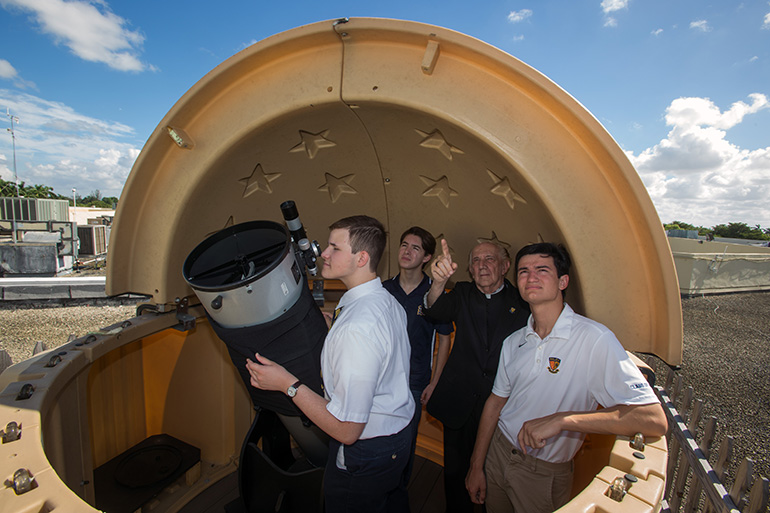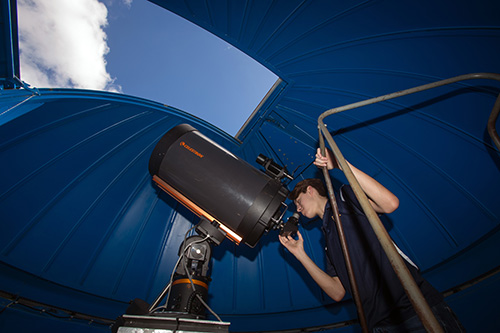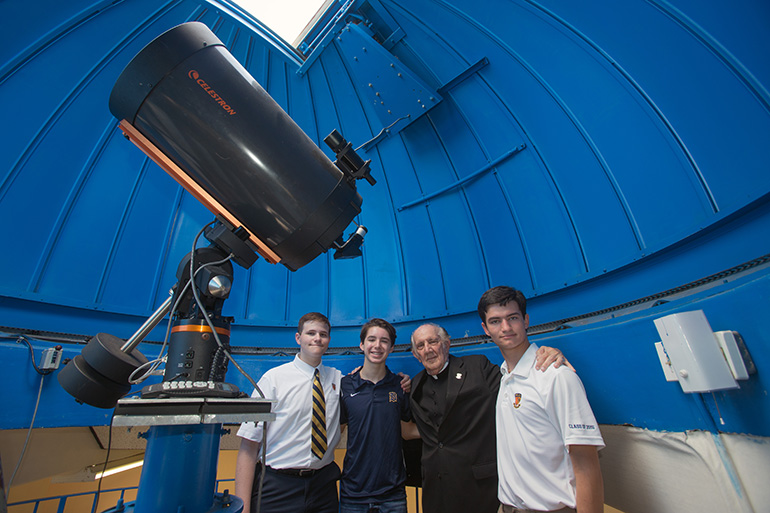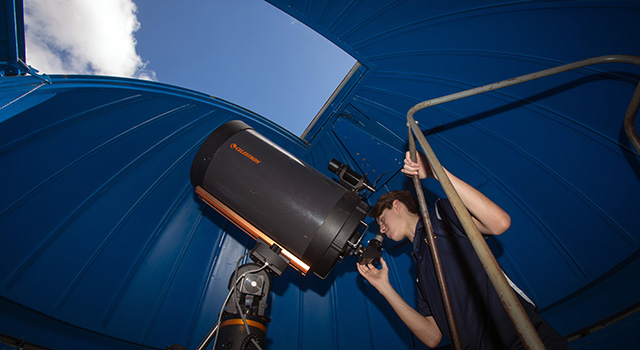By Tom Tracy - Florida Catholic

Photographer: MARLENE QUARONI | FC
Kevin Galego, 17, gazes through a 12" telescope on a Belen Jesuit rooftop as Danny Jimenez, 14, Jesuit Father Pedro Cartaya and alumnus Michael Cairo, 19, look skyward. Members of Belen Jesuit Preparatory School's Astronomy Club will use the telescopes to view and document the Aug. 21 total solar eclipse.
MIAMI | The student observatory at Belen Jesuit Preparatory School is eagerly awaiting the Aug. 21 astronomical phenomenon otherwise known as the Great American Eclipse.
Although Miami is not in the so-called “zone of totality,” the region will get a reasonably good seat at the country’s first, coast-to-coast, total solar eclipse in 99 years, as a 70-mile-wide lane of darkness will cut across 12 states from Oregon to South Carolina.
In South Florida, the sun, moon and earth will align in such a way as to cover about 80 percent of the sun’s visibility at the peak of the event, Monday afternoon roughly between 1 and 4 p.m.
Aug. 21 is also the first day of classes for archdiocesan schools, but students have been given the afternoon off to watch the eclipse safely at home. NASA has a website that will provide live coverage of the eclipse: https://eclipse2017.nasa.gov/
“We must be careful not to look at the sun without special filters and special glasses,” said Jesuit Father Pedro Cartaya, a spiritual counselor at Belen and founder of the observatory and student astronomy club begun here in the 1980s.
A native of Havana, Father Cartaya will coordinate some 20 astronomy club members and alumni who will watch and document the eclipse with a series of telescopes modified to safely observe the phenomenon.
In March of 1970, Father Cartaya said, he was in Perry, Fla., to observe another rare total solar eclipse that moved through Central America and the North Florida region.
“It was an amazing experience I will not forget,” he said. “A lot of astronomers from around the world were there. It was so dark.”
Belen is one of only a few schools in South Florida with an observatory. It has an array of 11 telescopes, and is the only school in the United States equipped with a 16” telescope with a CCD (digital) camera for astrophotography. The observatory will be accessible only to Belen’s student astronomers and related faculty during the eclipse.
Nationally, an estimated 20 million are expected to travel to better viewing areas for the eclipse. The three-hour event will include more than two minutes of total or near-total solar coverage in parts of Tennessee, Georgia and South Carolina.

Photographer: MARLENE QUARONI | FC
Danny Jimenez, 14, looks through the Belen Jesuit Observatory's 16" telescope.
According to the National Science Teachers’ Association, the sky becomes so dark during a total eclipse that the stars become visible and birds stop chirping because they think it is time to roost. Many feel it is one of the most beautiful natural sights and a once-in-a-lifetime happening.
Michael Cairo, a class of 2016 graduate of Belen now majoring in physics at the College of William and Mary in Virginia, will be on summer break in Florida for the eclipse and is planning to assist at Belen in his capacity as a former president of the astronomy club.
The club is purely a voluntary association for budding astronomy buffs, offering students no coursework or class credits. Cairo joined as a sixth-grader after being introduced to the observatory during a student orientation tour.
“This is pretty significant,” said Cairo. “Lunar eclipses are fairly common and I have seen about five of them but this solar eclipse happening around the continental U.S. is rare and I will remember this one.”
The club has ordered some 20 pairs of protective solar viewing glasses, he said, and the telescopes will be outfitted with solar filters and shielding, some of which they have used in the past to view and study the surface of the sun. One of the former club members will also be on hand to photograph the event.
“Belen is lucky to have a full observatory to see this and I am lucky to be here when it happens. Actually, the observatory at Belen is more complete than the one at my college so I will get the best experience here,” Cairo said.
Belen 12th-grader Kevin Galego, 17, a six-year member of the astronomy club and past vice president and president, said he was so wrapped up in studies this past spring that he only recently became aware of the approaching eclipse.
“I have always wanted to see a solar eclipse but have never seen them because often they appear over the Pacific islands and you would have to travel very far to remote areas to view them,” he said.
He added that he has observed lunar eclipses with his own telescope at home before he became a student at Belen.
“Solar eclipses are far more rare and they don’t last as long as lunar eclipses,” he said. The area “will be almost completely dark,” in contrast with a lunar eclipse which “just emits a reddish tint.”
Ninth-grader Danny Jimenez, 14, past president of the junior division of the astronomy club, got his first telescope around the fifth grade. He hopes to go on to a career in astrophysics and maybe even work for NASA.
“I thought it would be good to learn about that field and by observing the sky we learn about the vast universe we have,” Danny said. “I haven’t seen an eclipse before but I have looked at the sun with a filter on the telescope.”
Father Cartaya said a deep study of science and the natural world comes as a natural exercise for a Christian.
“We have a long tradition in our Jesuit order to work in the science and the more you dedicate to the sciences the closer you get to God and faith in God,” the priest said. “That has been my experience.”
For more information about the eclipse see: https://www.greatamericaneclipse.com/
Clarification: CCD stands for “charge-coupled device.” The term
refers to the image sensors that convert light into electrons, which is
basically what makes digital photography (on phones or tablets, without
film) possible.

Photographer: MARLENE QUARONI | FC
Kevin Galego, 17, Danny Jimenez, 14, Jesuit Father Pedro Cartaya, and alumnus Michael Cairo, 19, pose for a photo in Belen Jesuit Observatory with its 16" telescope. Belen is one of only a few South Florida schools with an observatory, and the only one in the U.S. with a 16” telescope with a CCD camera for astrophotography.

